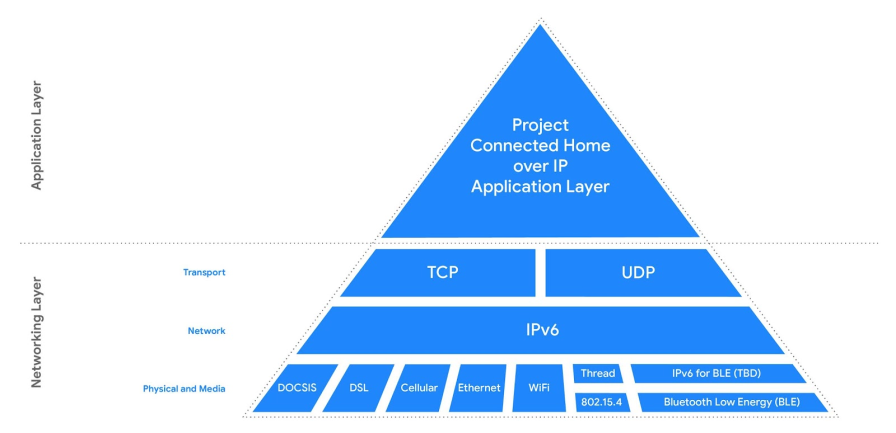SSZT165 may 2021 CC2652P , CC2652R , CC2652R7 , CC3220SF , CC3230SF , CC3235SF
Matter, formerly known as Project Connected Home over IP (CHIP), is a royalty-free connectivity standard developed within the Connectivity Standards Alliance, formerly the Zigbee Alliance. Matter runs on Thread and Wi-Fi® network layers and uses Bluetooth® Low Energy for commissioning. By providing a unified application layer based on proven technologies, manufacturers can leverage this open-source protocol to accelerate their development. Matter also improves compatibility for consumers and enables interoperability across the quickly expanding Internet of Things ecosystem so smart switches, smart hubs and smart thermostats from different manufactures can all work together in a home.
TI has been a promoter member of the Connectivity Standards Alliance for more than 10 years, a Thread Group contributor member, Wi-Fi Alliance contributor member and an early adopter for Matter, where we are actively participating in development efforts.
Here are some questions that you may have about Matter, and how to get started with development early.
Q:
What are the benefits of Matter? What does Matter mean for end-equipment developers?
A:
Matter simplifies the developer experience by reducing functionality specific to an ecosystem like Amazon Alexa, Apple Siri or Google Assistant, which may limit interoperability so that an end equipment can communicate and be controlled within any ecosystem. Matter provides a common layer for device life-cycle events – such as commissioning and provisioning, and device and profile discovery – over an Internet Protocol (IP) link (Thread, Wi-Fi, Ethernet). Successful certification for Matter devices guarantees interoperability between various manufacturers.
Q:
What are the benefits for consumers?
A:
Matter is compatible with smart home services such as Amazon Alexa, Apple Siri and Google Assistant. Any Matter-certified end product will be plug and play, complementing any given smart home ecosystem that did not previously guarantee communication between different ecosystems.
Q:
How do Zigbee and Matter compare?
A:
Although Matter is led by the alliance, it is not a replacement for Zigbee. The alliance will continue developing the Zigbee protocol. Matter application objects and interactions are heavily inspired by the Zigbee Cluster Library. As far as the differences, Matter requires IP-bearing networking protocols, while Zigbee specifies its own networking protocol.
Additionally, Matter defines provisioning schemes, which best suits expected user setup scenarios, over Bluetooth Low Energy and Wi-Fi QR codes. Zigbee’s standard commissioning process uses its native 802.15.4 radio.
Q:
What technologies does Matter run on top of?
A:
Matter provides an abstracted application layer that builds on top of IP protocols such as Wi-Fi, Ethernet and Thread, as shown in Figure 1. The unified application layer built on top of IP protocols improves interoperability for consumers and enables ease of development for solution providers across these connectivity protocols and technologies.
 Figure 1 Matter’s Abstracted Application Layer Builds on Top of IP Links (Source: Connectivity Standards Alliance)
Figure 1 Matter’s Abstracted Application Layer Builds on Top of IP Links (Source: Connectivity Standards Alliance)Q:
Which devices will support Matter?
A:
Matter-enabled devices can operate in two different configurations, such as:
- System on chip (SoC). A Matter SoC runs all Matter layers on a single device. This configuration is a good fit for systems where the main system function is the Matter application. An SoC is common for higher-volume products such as lights, sensors or smart locks.
- Co-processor. A Matter co-processor runs a subset of Matter layers and pairs with another main processor to create a complete Matter solution. There are two possible types of co-processors: network co-processors (NCPs) and radio co-processors (RCPs).
TI’s SimpleLink wireless connectivity portfolio will support all major Thread-based system topologies for Matter accessories. Table 1 lists the devices in the SimpleLink portfolio that support Matter over Thread and Wi-Fi. Matter defines Bluetooth Low Energy usage primarily for device discovery and provisioning.
| Device | Flash/secure random access memory | Matter device roles | Other capabilities | Production date |
|---|---|---|---|---|
|
CC2652R
CC2652P(1) |
352 kB 80 kB |
Thread NCP Thread RCP |
Concurrent Bluetooth Low Energy |
In production |
| CC3220SF | 1024 kB 256 kB |
SoC – Wi-Fi | Secure boot Secure key storage Wi-Fi Protected Access (WPA)3 |
In production |
| CC3230SF | 1024 kB 256 kB |
SoC – Wi-Fi | 2.4 GHz Secure boot Secure key storage Bluetooth Low Energy coexistence WPA3 |
In production |
| CC3235SF | 1024 kB 256 kB |
SoC – Wi-Fi | Secure boot Secure key storage Bluetooth Low Energy coexistence Dual band (2.4 GHz and 5 GHz) WPA3 Federal Information Processing Standards 140-2 level 1 |
In production |
Matter provides a unified application layer that simplifies development for manufacturers and improves interoperability between smart devices. Visit TI.com/Matter to get started with development resources like our updated software development kits for Matter-enabled MCUs. Also, check out our Matter technology demo: Unified standard for connected objects.